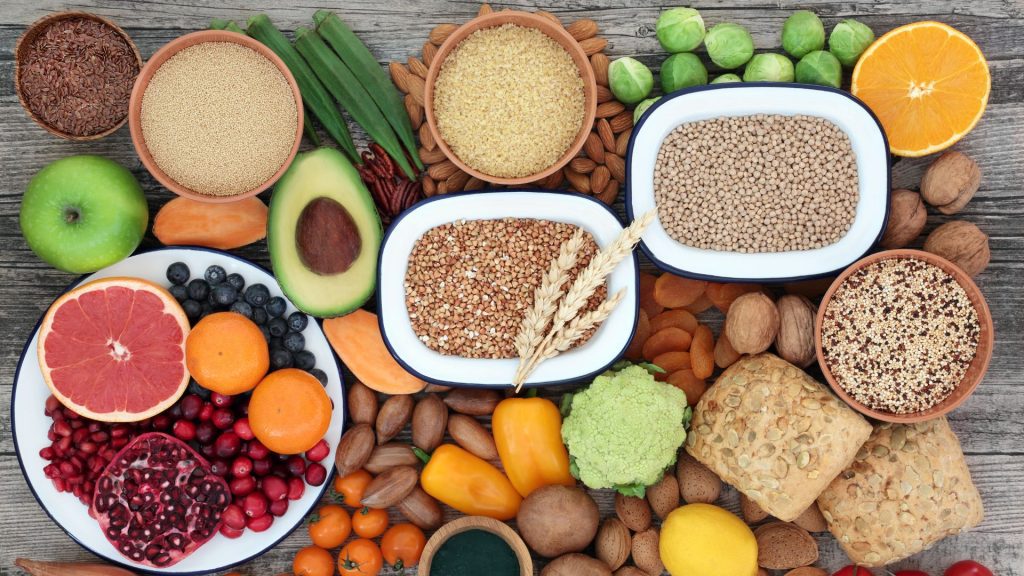You’ve heard of matcha, quinoa, kombucha and goji berries. These fashionable ‘superfoods’ have all had their moment in the spotlight over the years. But what if the real health hero has been staring at us in the face all this time? Well, it has and it’s called fibre.
It’s not sexy or exotic but fibre is, in my opinion, the real ‘superfood’ of today and it deserves more attention in our diets. Particularly as recent studies show that 80% of Irish people are not getting enough fibre (The Irish Heart Foundation). It’s really important to eat enough fibre to reduce your risk of heart disease, stroke, type 2 diabetes and colon cancers. (NHS) Fibre also supports a healthy gut microbiome and helps to maintain a healthy weight, but more on that later!

So, what is fibre and why do I need it?
Fibre is found in the edible parts of all plants such as fruit, vegetables, wholegrains, beans, pulses, nuts and seeds. It is needed to move food through the digestive system effectively and to prevent constipation, bloating and discomfort. In regulating digestion, a high-fibre diet can help to prevent disorders of the digestive tract such as IBS, diverticulitis and hemorrhoids.
Fibre comes in two forms: soluble and insoluble, both of which we need for our bodies to function properly.
Soluble and Insoluble – what’s the difference?
Insoluble fibre, often referred to as ‘roughage, isn’t broken down by the body, as the name suggests. It passes through the digestive system, bulking up stools and flushing the colon out, helping to keep you regular. It’s found in wholegrains, vegetables, beans, fruit, nuts and seeds.
Soluble fibre on the other hand, dissolves in water and forms a gel-like substance in the intestines which softens stools. It’s found in beans and grains, particularly oats, oat bran and barley. This type of fibre slows down the absorption of glucose (blood sugar) from carbohydrates and binds to ‘bad’ cholesterol in the blood, helping to lower blood cholesterol. High blood sugar levels over time can lead to weight gain and type 2 diabetes. Also, as high-fibre food is more filling (think porridge over corn flakes), people tend to eat less food, preventing weight gain.
On top of this, fibre (and variety) is really important for a healthy microbiome (the good bacteria found in the gut) to flourish. A healthy gut has many benefits from keeping colds and flus away to boosting mood. Studies have shown that a huge 70% of the immune system is located in the gut. The majority of our serotonin (the ‘happy hormone’) is produced here too. All the more reasons to care for it!
Finally, fibre is needed to excrete toxins (such as pesticides) and excess hormones from the body which is needed for healthy skin.
How much do I need?
It is recommended that we get 30 grams of fibre/day. While this mightn’t sound like a lot, most people eating ‘western’ diets (high in refined carbohydrates and processed foods) are not reaching it. So, let’s look at how we can improve this.
Where can I get it?
The best way to obtain enough fibre is by eating plenty of fresh, whole (minimally processed) foods from plant sources such as fruit, vegetables, wholegrains, beans, nuts and seeds.
My Top 10 Tips
Here are some ways you can improve your fibre intake:
- Swap white carbohydrates for wholegrain versions- Replace white bread with whole meal varieties and look for ‘whole-wheat’ or ‘whole’ flour in the first few ingredients. Go for wholegrain rice and pasta over white versions. Even swapping to half white/half brown is a good start! Try out some different grains such as millet, quinoa (it has its place!), couscous and barley (add to soups) to keep things interesting too.
- Eat more beans- Beans have so many benefits, being full of protein and packed with fibre. Experiment with different types; try adding chickpeas to salads, black beans to fajitas or add a tin of ‘meatier’ butterbeans to stews and casseroles to bulk them up. Try a lentil Bolognese instead of beef or blend a tin of beans into tomato sauces for kids.
- Add 1-2tbsp seeds or nuts daily- This is a really easy way to up your fibre count and boost your breakfast or lunch. Chia and flaxseeds seeds are especially high in fibre and are easy to add to porridge, yoghurt and soups. Toasted pumpkin and sunflower seeds are a delicious, crunchy topping for salads too. All nuts help increase your fibre intake too.
- Choose a high fibre breakfast: Porridge oats, bran flakes, Weetabix and Oatabix are all good options instead of more refined cereals. Add a portion of berries or a chopped banana & sprinkle of nuts too. If you prefer eggs, include a side of vegetables such as spinach, kale, peppers and mushroom. Avocados are also a great source of fibre.
- Hydrate, hydrate, hydrate! Fibre needs to work with water to pass through the digestive system. Make sure you are getting 2 litres daily to prevent constipation particularly when increasing your fibre intake. Herbal teas are great or add some lemon, mint or cucumber slices to water to add flavour.
- Up your vegetable intake- Aim for 5 vegetables and fruit per day, with more vegetables than fruit (higher in sugar). Try to add one more vegetable to boost meals. Have a bowl of soup with whole meal bread for lunch (extra points for adding beans!) or include a side salad. Frozen vegetables are excellent too; they tend to be fresher so higher in nutrients and are easy to always have to hand. Balance out fruit smoothies with a vegetable such a spinach, frozen cauliflower (it has no taste!) or some avocado for creaminess.
- Eat your skins: Yes our parents were right, the goodness really is in the skins! Most of the fibre in a potato is in the skins. Try to bake them rather than boil or make wedges and wash carrots and parsnips instead of peeling them.
- Up your snacks game! Choose a healthy, high-fibre snack option such as a cup of homemade popcorn, vegetable sticks with hummus or apple slices (skins on!) with a sprinkle of cinnamon and 1tsp of almond or peanut butter. Chickpeas are also delicious roasted with a little olive oil and some spices. Add some berries and seeds to a pot of Greek yoghurt.
- Read food labels: Check the fibre contents of the foods you usually buy. High-fibre foods contain more than 6g of fibre per 100g. Foods that contain less than 3g of fibre per 100g are low in fibre. (HSE)
- Finally, take small steps. Increase your intake gradually to allow your body to adjust to it as a sudden increase could cause bloating or constipation. Start with improving one meal or implementing 1-2 tips at a time and drink plenty of water. Remember, small steps are better than none and it’s those little, consistent daily habits that make a big difference overall!
Alumni Article
Guest written by IINH graduate Michelle Kelly
You can find Michelle on Instagram @eatwell.withmichelle












